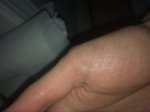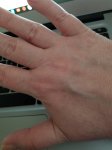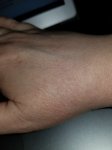I woke this morning and notice you've already done a great job overnight in adding a
Pathogens and collagen degradation section to the collagen MEpedia page!
I'll just post here some of the refs and info I have collected about connective-tissue / extracellular matrix destroying enzymes, in case you find these useful.
Some basic definitions
➤ Extracellular matrix (ECM) — exists in the space between the cells, and acts as scaffolding that holds the individual cells together, creating a structured tissue. This matrix consists of proteins such as collagen (the most abundant), elastin (the next most abundant), fibronectin, laminin and others.
➤ Connective tissue — one of the 4 basic types of tissue in the body (the other 3 are epithelial tissue, muscle tissue and nervous tissue). Connective tissue is the scaffolding that structurally supports and binds organs and tissues. All 4 basic tissue types possess an extracellular matrix, but the extracellular matrix is particularly rich in connective tissue.
➤ Matrix metalloproteinases (MMP) — are a family of enzymes which break down the collagen, elastin, etc proteins of the extracellular matrix.
MMPs are secreted by the body for various purposes, such as during the growth of new blood vessels, or during wound healing and tissue repair. MMPs are also secreted by the immune system in order to "hack a path" through the tissue extracellular matrix to allow immune cells in the bloodstream to travel into these tissues to fight an infection (ref:
1). But bacteria also secrete MMPs for the same purpose: to hack a path through in the host tissue, allowing the bacterial infection to invade and spread into the host.
There are around two dozen MMPs, and each one targets a specific set of ECM proteins like collagen, elastin, etc. There is a nice list of MMPs
here, also a list on Wikipedia
here.
Quest and Labcorp both offer
tests for blood MMP-9 levels.
➤ Neutrophil elastase (also called human leukocyte elastase, or HLE) — is another enzyme which breaks down elastin, collagen, etc. It's not considered part of the MMP family as far as I am aware.
Neutrophil elastase was
found elevated in ME/CFS by Kenny De Meirleir. RED Labs offer a
test for elastase levels in ME/CFS patients.
KDM thought that this neutrophil elastase was responsible for cleaving RNase L, and creating the chopped up low molecular weight RNase L that has been found in ME/CFS (see KDM's
book). I am not sure if this line of investigation still holds currency.
This 2012 study by Dr Maes also found polymorphonuclear leukocyte elastase (= neutrophil elastase) elevated in ME/CFS.
➤
Tissue inhibitors of metalloproteinases (TIMP) — the enzyme activity of the MMPs is inhibited when TIMP is secreted. Thus when TIMP levels are higher, the extracellular matrix-destructive effect of MMP enzymes is reduced. There are four of these inhibitors: TIMP-1 to TIMP-4.
Effect of enterovirus infection on MMP levels
Acute coxsackievirus B3 myocarditis in mice has been shown to cause elevated MMP-2 and MMP-9 in
one study; and elevated MMP-2, MMP-9 and MMP-12 in
another study.
Chronic coxsackievirus B3 myocarditis in mice has been shown to cause elevated MMP-2 and MMP-3 in
one study (at the 28 days stage, which is the chronic infection stage).
Acute coxsackievirus B4 infection of the pancreas in mice led to elevated MMP-9 (mainly originating from macrophages and neutrophils),
one study found.
Effects of manipulating of MMP levels in enterovirus infection
In acute coxsackievirus B3 myocarditis in mice,
one 2008 study found that reducing MMP-9 levels (by gene knockout) led to worsened myocardial injury. So MMP-9 appears to have a protective effect against this virus, at least in acute infection.
However, the chronic non-cytolytic enterovirus infection found in ME/CFS (and chronic myocarditis) however are a different beast to acute infection, and so the protective effect of MMP-9 may not necessarily apply in chronic enterovirus infection.
A
2003 study found MMP-9 (gelatinase B) cleaves interferon beta, destroying its antiviral effect. So in this case MMP-9 is weakening the immune response.
A
2014 study found that MMP-12 (macrophage elastase) limits the antiviral immune response by destroying the interferon alpha receptor 2 binding site. This suggest that inhibiting MMP-12 may help to control coxsackievirus B infection. Though currently no MMP-12 inhibitor drugs are clinically available.
Inhibitors of MMPs
This study on multiple sclerosis patients found MMP-9 was decreased by 58% after 3 months of
omega 3 fish oil supplementation at 9.6 grams per day.
This rat study found
alpha lipoic acid reduced MMP-2 and MMP-9 during ischemia-reperfusion injury.
This rat study found the angiotensin II receptor blocker drug
losartan and the statin drug
simvastatin increased TIMP-1 and TIMP-2 (thereby inhibiting the effects of MMPs).
This human study found
losartan decreased MMP-2 and MMP-9.
This study found the angiotensin-converting enzyme (ACE) inhibitor
captopril inhibits serum MMP-9 in patients with Kawasaki disease.
Dr Ritchie Shoemaker uses a
low amylose diet and
high-dose fish oil to treat elevated MMP-9.
This study found
glucosamine sulfate inhibits MMP-2 and MMP-9 expressions in human fibrosarcoma cells, probably explaining why glucosamine is effective in relieving the symptoms of osteoarthritis.
This study found
azithromycin decreases MMP-9 expression in the airways of lung transplant recipients.
This in vitro study found that
doxycycline inhibited MMP-13 and MMP-8 (at concentrations that were near the concentrations achieved in the serum after oral dosing).
This in vitro study found
magnesium reduces MMP-2, suggesting that the beneficial effect of magnesium supplementation on the cardiac disease may be due, at least in part, to the inhibitory effect on MMPs.
There are many other supplements that inhibit MMPs in vitro: see
here; but most of these supplement probably will not work in vivo when you take them orally.
(This is because it is easy to produce effects in vitro in a cell line, because you can use high concentrations of the compound. But those high concentration are often not obtainable in vivo for various reasons, such as the maximum safe oral dose, or poor bioavailability. So you need to find studies that show a drug or supplement works in vivo in humans or animals).






